Elderly Chinese Immigrants Crammed into Garage Dormitories - Inside Southern California's Family Hotels
The story was co-published with El Tecolote as part of the 2025 Ethnic Media Collaborative, Healing California.
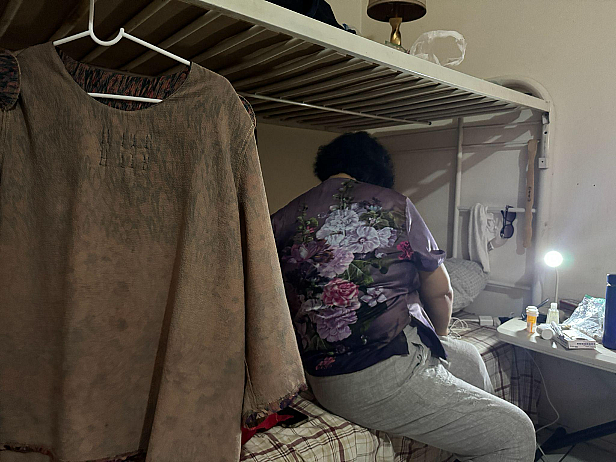
Seventy-six-year-old C. Zhu pays $18 a night for a bunk bed in a converted garage. Photo by Jian Zhao, World Journal
Los Angeles County is among the least affordable places in the United States, particularly for seniors on a fixed income. A market-rate studio apartment in Chinatown rents for about $2,000 a month, while the maximum federal SSI benefit for a senior is just over $1,200. For many low-income Chinese seniors, the math doesn't add up.
Subsidized senior housing can be a lifeline, but waitlists stretch for years. New applications open rarely and close almost immediately. For seniors facing language barriers and limited digital access, the process is even more daunting.
The alternatives can be bleak. Behind ordinary-looking houses in the San Gabriel Valley and aging storefronts in Chinatown, seniors are squeezed into improvised spaces: garages divided by curtains, boarding houses that charge by the day, or crumbling upstairs rooms above restaurants and groceries.
From the street, these buildings look unremarkable. Inside, they reveal hidden rooms where survival replaces dignity.
A Bed for $18 a Night
One of those residents is C. Zhu, a 76-year-old diabetic who moved from a remote town in Northern California where her son lives to San Gabriel. There, in a so-called “family hotel,” she pays $18 a night for a bunk bed in a converted garage.
The garage structure holds four small bedrooms, with residents all sharing a single greasy kitchen and a bathroom streaked with mold. Men and women live side by side with only thin curtains for separation. In Zhu’s room, three makeshift beds and one bunk bed are crammed into the space. Her spot is near the entrance, where strangers drift in and out, sometimes half-dressed in the summer heat.
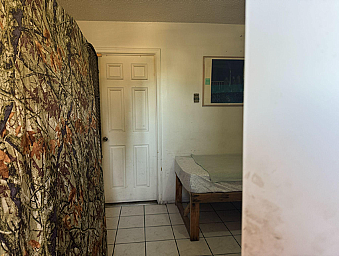
C Zhu covers her bed with a blanket for privacy. Jian Zhao, World Journal
There is no lease or deposit, only a manager who keeps Zhu’s two suitcases as collateral. Even at that price, she struggles to afford the place. She showed records showing she has already borrowed more than $8,500 from relatives in China.
Zhu, a green card holder, immigrated to the United States years ago with her son. She doesn’t speak English and has never been able to find work. She just obtained Medi-Cal health insurance but doesn’t know how to use it or where to find a doctor. As her diabetes worsened, she began using leftover medication shared by church members. “My legs are swollen now,” she said. “I can’t walk far, and I can’t work anymore. I wish I could find a housekeeping or nanny job, but my health won’t let me.”
Zhu previously lived with her son in Clearlake, a rural community several hours north of San Francisco. The isolation, she said, was crushing. Without a car, she could not reach doctors or social workers who spoke Chinese..
A friend of her son suggested she move to the San Gabriel Valley, where a large Chinese community offers easier access to doctors and resources in her language. But now she is here, trapped in a boarding house.
“At least it is not the street,” Zhu said. She is currently trying to navigate the medical system with the help of Chinese-speaking professionals and social workers.
In the San Gabriel Valley, some boarding houses have operated for decades. For new arrivals, these places are often the first stop. For elders, they can become the last. Some have lived in the same rooming houses for decades, resigned to conditions others would never accept.
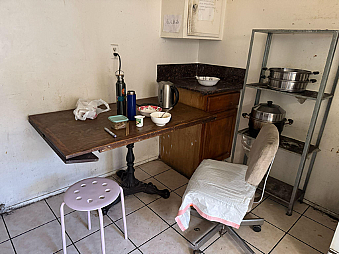
A table set up for residents to eat their meals. Jian Zhao, World Journal
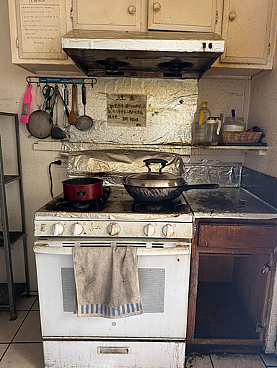
The kitchen where the residents cook their meals. Jian Zhao, World Journal
A McGill University study found that overcrowded housing contributes to respiratory illness, the spread and severity of infections, household accidents, and even psychological distress — risks that are especially concerning for aging populations.
The Housing Gap
Subsidized apartments for seniors do exist, but openings are rare. Tan and Sue, social workers from Tzu Chi,a nonprofit providing healthcare service to disadvantaged people, say new applications for Section 8 housing have been closed for years, and waitlists can stretch six to eight years. “Those who got in applied long ago,” said Tan, who has worked in the Chinese community for 25 years. “For newcomers, it’s almost impossible.”
Without access to subsidized housing, most seniors rely on makeshift solutions: splitting bedrooms with strangers, renting a bed in a boarding house, or moving between temporary jobs that provide room and board. Conditions are often appalling.
According to the social workers, residents describe landlords who forbid cooking, rooms where a dozen tenants share one bathroom, and cramped basements divided by thin partitions.
For some, the only fallback is returning to their homeland. “We’ve seen seniors with cancer who had no income and no options here,” said Sue. “After decades in America, they went back to China for family support.”
Cultural Barriers
Even when programs or shelters are available, cultural stigma around such programs adds another barrier. In Chinese communities, the word homeless is synonymous with being a beggar — a total loss of face.
“They would rather live with a dozen people in a room than line up at a shelter,” Sue explained.
Shelters themselves present practical hurdles. Tzu Chi social workers say that intake is usually in English or Spanish, beds reset daily, and priority goes to families with children. For elders who don’t drive, don’t speak English, and have limited access to information, the system feels out of reach from the start.
Stigma and avoidance of shelter programs also distorts the data. According to the study co-published by USC Sol Price School of Public Policy and the UCLA Asian American Studies Center, Asians are underrepresented in official homeless counts, even though poverty rates are similar to other groups. Many Chinese seniors avoid registering as homeless, relying instead on borrowed money, relatives, or the network of cheap boarding houses that keep them hidden from public view.
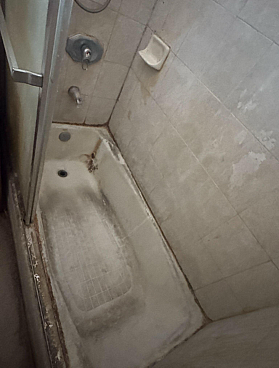
The shared bathtub. Jian Zhao, World Journal
Life Above the Shops in Chinatown
In Chinatown, the contrast is most visible. On North Broadway, aging two-story buildings above groceries and souvenir shops are packed with tiny units, each window covered with cardboard, heavy curtains and sundries. Inside, as many as 30 tenants might share a single kitchen and a few showers.
“I pay $700 a month, utilities included. We have one kitchen and four bathrooms for 30 units,” said an elderly Vietnamese Chinese resident who requested anonymity out of fear of eviction, standing at the entrance of his building and watching pedestrians go by.
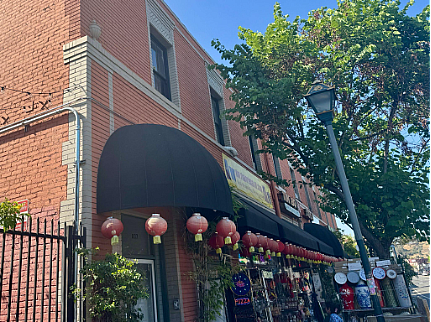
According to the resident, there are 30 units on the second floor of this building in Chinatown. Photo by Jian Zhao, World Journal
He has lived there for three decades. “I came from Vietnam in 1981. The owners have changed several times, but the setup stays the same…Rent used to be cheap, now it goes up about 10% every year. We pay the building manager directly.”
Several of his neighbors have also lived here for decades, he said. With no air conditioning, summers are sweltering and the winters cold
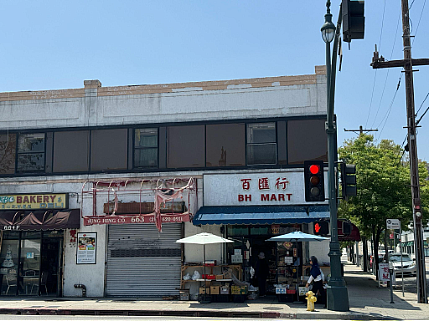
On North Broadway, aging two-story buildings above groceries and souvenir shops are packed with tiny units, each window covered with cardboard, heavy curtains or sundries. Photo by Jian Zhao, World Journal
Ms. He, a woman in her seventies, bought her own air conditioner for the small unit she has shared with a roommate for over a decade. The room is crammed with belongings, leaving barely enough space to walk. On her floor alone, there are about 20 such units. Her neighbors include disabled tenants, undocumented immigrants, and other Chinese elders.
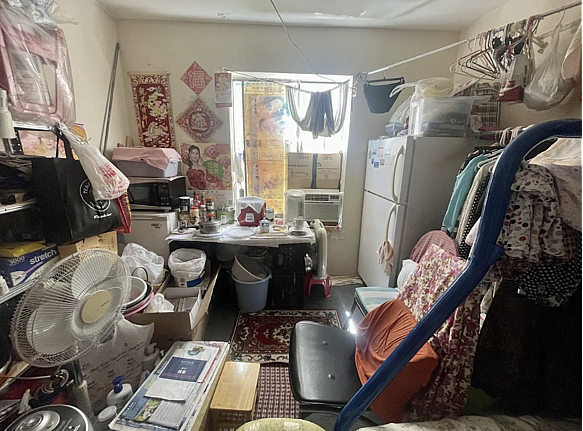
Ms He‘s unit in Chinatown. Courtesy of World Journal
A local study by Abundant Housing LA found that overcrowded neighborhoods in Los Angeles, especially those with high numbers of uninsured residents, face worsening sanitation, poor ventilation, and greater exposure to disease. These conditions heighten the risk of infection and chronic illness.
Across the street, expensive new commercial apartments rise. The gap between old and new could not be starker. RentCafe reported a median rent of $2,744 in Chinatown for September 2025.
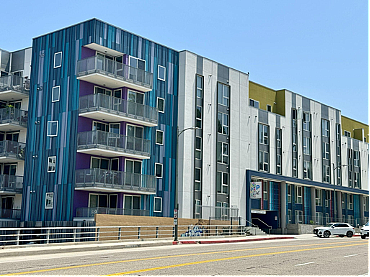
New commercial apartments on North Broadway, Chinatown. Photo by Jian Zhao, World Journal
For longtime community organizer King Cheung, who co-founded the Chinatown Community for Equitable Development (CCED) and has worked in the neighborhood since the 1980s, the scene is all too familiar.
“Chinatown was the first stop for Chinese immigrants,” he said. “Those who earned more eventually moved out, but low-wage workers stayed. Now, many of the elders here survive on SSI.”
Cheung noted, most of these elders spent their lives in restaurants, markets, or garment factories. They don’t speak English or drive, which limits where they can live. In Chinatown, however, they can still shop, see a doctor, and communicate in their dialects — often Cantonese or regional varieties that even Mandarin speakers struggle to understand. Cars are expensive, but here, daily life remains within walking distance.
“In other parts of Los Angeles County, they would feel isolated,” Cheung added. “Here, despite everything, Chinatown still feels like home. And most importantly, they can still find rents this low.”
A Fragile Safety Net

Advocates and social workers who work on the front lines with seniors see these living spaces with mixed feelings. They are cramped, unsafe, and undignified. Yet they are also a fragile safety net, keeping many elders from ending up on the street. “Without them, they would be on the street,” said Tan.
The price of this survival includes crowding, substandard conditions, and a daily erosion of dignity. Some elders live out their last years in these hidden rooms. Others shuttle between families, employers, or distant relatives. They rarely appear in stories of homelessness or statistics. They are not visible in shelters or on the sidewalks, yet their hidden rooms and quiet suffering are part of the housing crisis.
This project was supported by the USC Annenberg Center for Health Journalism, and is part of “Healing California”, a yearlong reporting Ethnic Media Collaborative venture with print, online and broadcast outlets across California.

